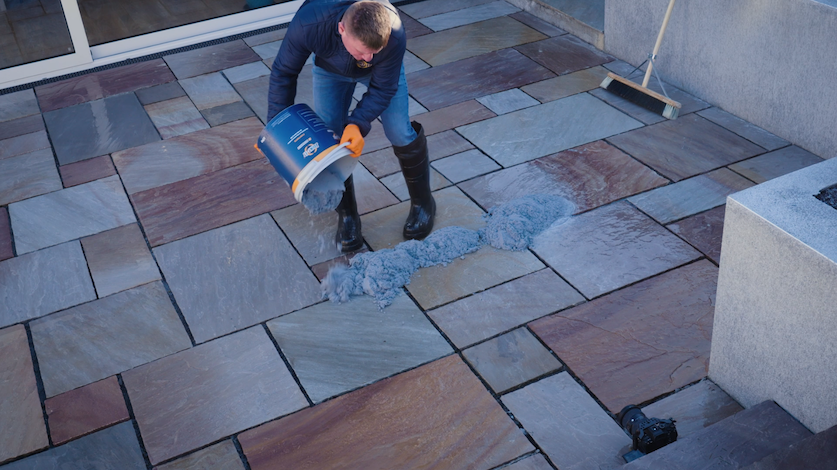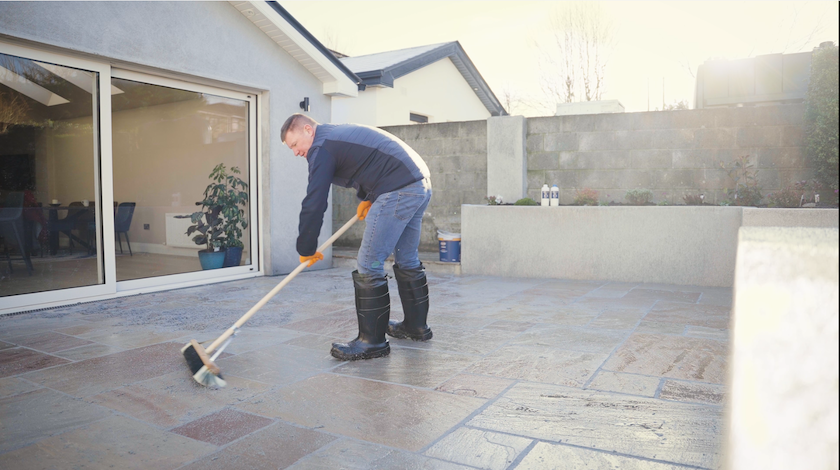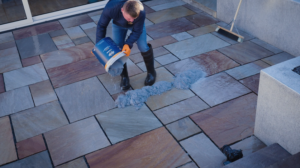Pointing a patio is a crucial step for installing a paved area that lasts. But what happens when the weather doesn’t cooperate? Explore whether you can point a patio in all types of weather conditions, from hot sunny days to cold winter blasts, and those many rainy days in between. Uncover the top weather-based tips for successful grouting at most times of year.
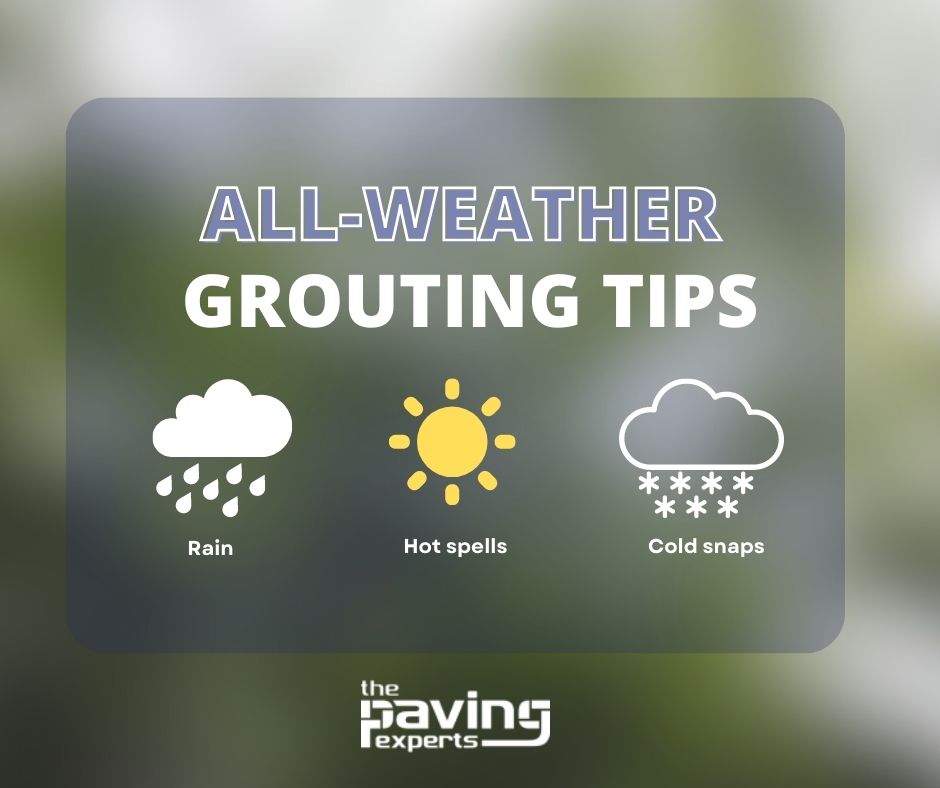
Can I grout in any weather?
Weather is a crucial factor to consider when you’re choosing a time to grout a patio.
Although recommendations can differ depending on the type of grout you’re using, there are certainly big alarm bells on some weather conditions when you should avoid grouting altogether.
You especially need to consider what the weather is doing when using a cementitious slurry grout or sand to cement mortar mix.
In this all-weather paving guide, we’ve also considered what the experts say about popular brush-in grouts.
Regardless of the advice given here, you must always check the manufacturer’s instructions for their specific weather-based application tips. Some products may have slightly different formulas and so advice may vary.
Pointing a patio in the rain
Let’s face it, with our beautiful British weather there often comes a time when the heavens open and the final stages of installing a paving project has to be postponed.
So it’s important to familiarise yourself with when it’s safe to continue work – and when the need comes to pack away your tools for another day.
Whether you can complete a pointing job in the rain really depends on the type of grout you’re using for the job.
Crucially, it also depends on how heavy the rain is and what the forecast says.
Brush-in grouts
When using a sand-based grout with no cementitious content, such as EasyJoint or PremJoint, you should be fine to lay the paving in the rain.
Some experts say that using a brush-in grout in the rain can actually make the job easier. A wet jointing compound can be manipulated into the joints much more smoothly than a dry grout.
Be aware that grouting in the rain is only advised on permeable projects.
With a fully permeable bed, the excess water will freely drain through the bedding layer.
When applying a brush-in grout during a heavy shower on an impermeable bed, the joints are likely to fill-up with rainwater and can even push the formula out.
Using slurry grouts in the rain
You must keep an eye on the scale of the shower if you are using a cementitious jointing compound such as a sand to cement mix, or popular off-the-shelf slurry grouts like UltraScape’s Flowpoint or Fuga-Pave Flex CH grout.
Similar to brush-in grouts, a little rain can be beneficial when applying cement-based formulas.
Most manufacturers of slurry grouts advise to keep the area damp with a sprinkle of the hose. So a very light shower can help to ease application and stop the slurry from drying on slab surfaces.
However, anything heavier than a light drizzle is way too much rain for a slurry mix to cope with.
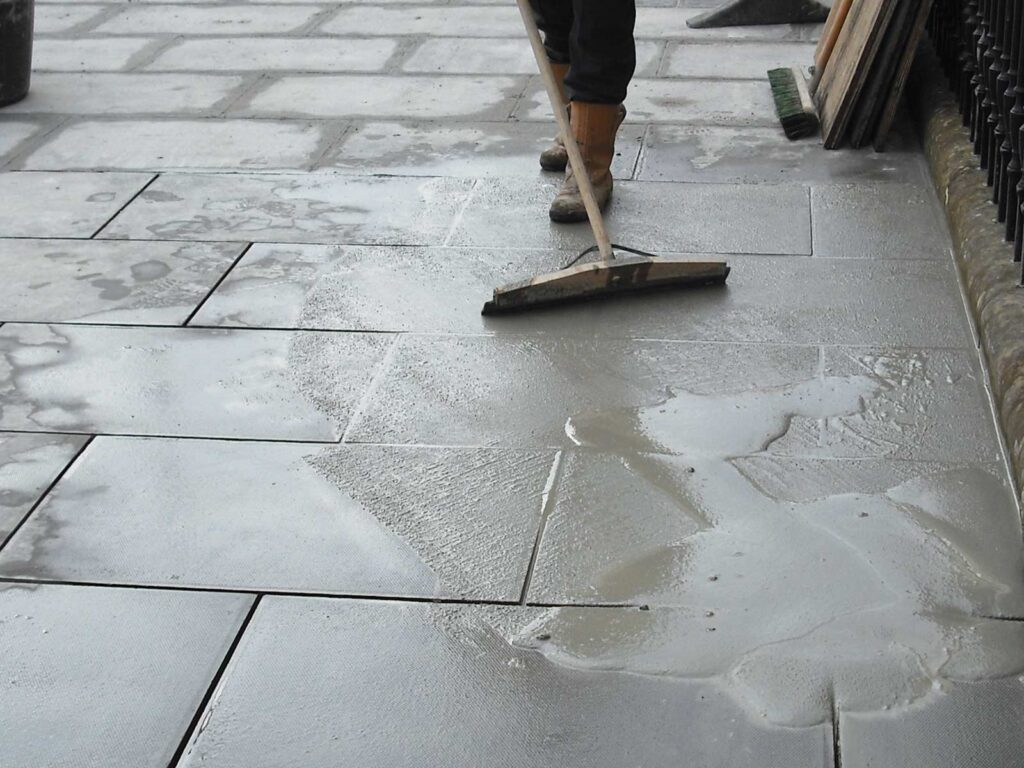
Medium to heavy showers will weaken the slurry formula and, once dried, cause it to crack and break. An excess of water in the grout can cause paving failures, stains, or efflorescence further down the line.
When assessing whether to grout in the rain, there’s an important rule of thumb: if the joints are filling up with water, then it is way too wet to grout.
In these types of conditions, it’s best to postpone your pointing job to another day.
Pointing pavers during hot weather
Wondering what temperature is considered too hot for grouting?
Temps of 30ºC and higher are way too hot for grouting with most – if not all – grouts. As mentioned earlier, always check the manufacturer’s instructions.
There is an extra big risk of using slurry grouts or traditional sand to cement mortar mixes during hot temperatures.
Extra heat will remove moisture from the mortar much too quickly. The result? The quality of the formula may be compromised if it dries too early in the process.
Most slurry grouts will set more quickly at temperatures of 25ºC and above. So although you can sometimes still grout at these temps, you do risk shortening how much time you have to work with the product before it sets.

Most off-the-shelf grouts are tested for their workability and setting times at 20ºC.
Be aware of the conditions and ensure the area is kept constantly damp. During warm weather you may find yourself constantly misting the area to keep it damp.
Brush-in grouts can also be compromised during hot temperatures. As with slurry grouts, it’s important to keep the area constantly damp. Even brush-in formulas can dry rapidly on paving slabs in hot weather, leaving a residue of oil that can ultimately stain the slabs.
In warm weather conditions like these, landscaping experts say grouting is much easier as a two-person job. Arrange one person to install the grout into joints and the other on the hose to keep the area damp.
Never saturate the paving. Keeping the surfaces damp with a light mist is usually enough.
Extra tips on pointing in warmer weather
During warm weather spells, there are clever things you can do to slow down curing times and avoid stained surfaces:
- Point the patio during the coolest part of the day – the weather will be much cooler early morning (avoid late afternoon as the slabs will have absorbed the day’s heat)
- Keep the paving constantly damp with a light mist of water (never saturated)
- Consider pre-soaking paving slabs, especially when using porous materials like sandstone
- When mixing formulas with water, first run the tap for a few minutes until the water is colder
- Use a slower mixing speed to avoid adding any extra heat to the mix
- Only grout small areas at a time – and always one bag at a time
- Keep your unopened bags of grout out of the heat, store in the shade
Take extra care with dark materials
The team at Fuga-Pave say to take particular care in warmer weather when working with dark materials like black limestone or slate.
“Black attracts and retains heat,” says Jim Stott. “This will cause the polymers to cook – it will make the grout stick and become extremely difficult to move.”
Equipment for quick and easy pointing work
If you’re concerned about applying the right amount of water during the wash-off stage, have you considered using a sponge machine?
Sponge machines, like the Berta ADV Sponge Machine, add the right amount of water during clean-off, removing any extra hassle or concern. Using a sponge machine reduces the need to constantly mist the area.
Extremely easy to use, the Berta also helps you speed through clean-up jobs. In fact, using one of these machines means you can clean-off grout from an area of 100m2 within just an hour!
After buying a Berta himself, Jon Gerrish from Paved in Stone used it on a 130m2 paving project. “The Berta was ideal as we had all of the paving laid and cleaned in a day!”
Jon says the Berta has already paid for itself. “After using it for paving around 300m2 it’s well worth the money and gives a return on investment.”
Pointing a patio in cold weather
Along with rain and hot weather, you also need to be aware of onslaughts of cold weather when pointing a patio.
Most grouting formulas have set minimum temperatures for usage – and those directions are there for good reason.
As an absolute rule, never grout when the ground is frozen. The frozen ground can affect the formula by adding extra water to the mix once the ground has thawed.
And it’s this additional water that is one of the main causes of efflorescent stains occurring further down the track (although another major one is failing to sufficiently prime pavers).
Minimum temperatures for grouting are usually around the 5ºC mark – and rising. Products are deemed to be effective at those minimum temperatures so it’s important to follow them.
Always be aware that the ground temperature will be a few degrees lower than the temperature stated on your weather app.
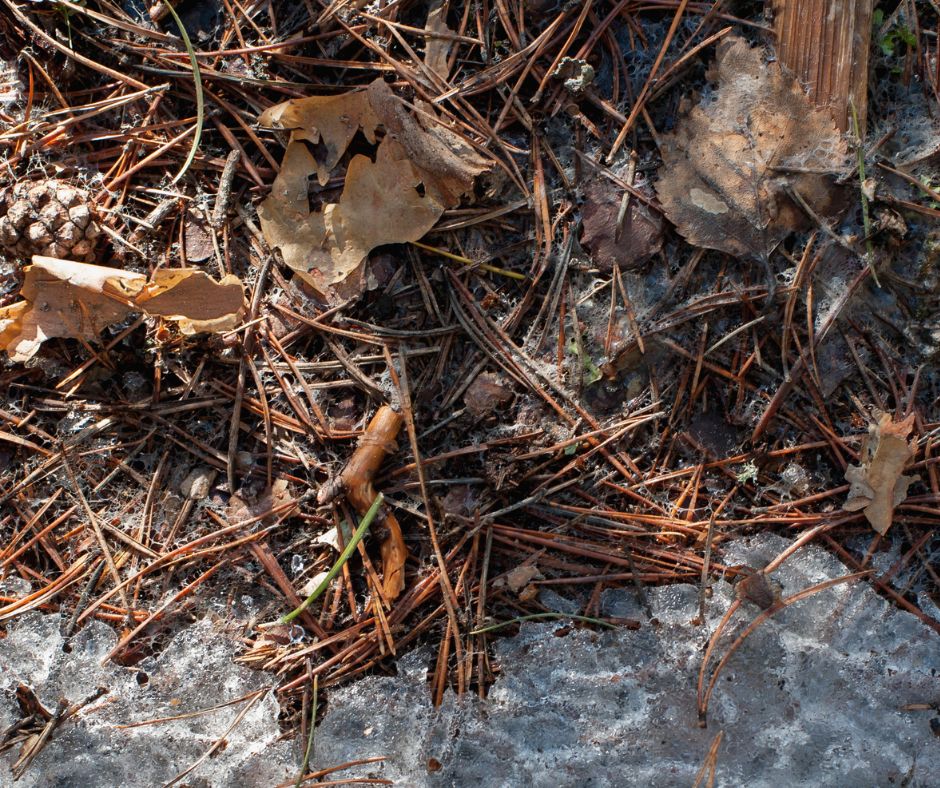
Just as warm-weather grouting should be done early in the day to avoid the hotter temps, with cold-weather grouting it’s best to start the job later in the day when the ground is completely frost free and the temperature is rising (i.e. it’s not getting colder!).
Grouts will take longer to cure during colder weather. Generally speaking their setting times have been tested at 20ºC so it can be much longer than the quickest time stated on the packaging.
When using slurry grouts like Larsen FJM and Flowpoint, always ensure the product has set before washing it off. In cold weather, you may need to wait a little longer than usual before washing off the product. With Flowpoint, look for that moment when the product has stopped ‘bleeding’ from the joints.
Summary of pointing tips during cold spells
Take stock of the tips for pointing patios during cold weather:
- Always follow the manufacturer’s instructions on minimum temperatures
- Make sure the ground is free of frost and the temperature is rising
- Start your pointing job later in the day when the weather is warmer
- Make sure the hose or sponge machine is free of frost before using them
- Consider mixing formulas for longer to add a little more heat to the formula
- With slurry grouts, make sure the product has properly set before wash-off
- Protect products during storage – store off the ground and away from damp
Premjoint brush-in grout can be used at 3ºC and rising. But even with this brush-in grout, during cold temps you must avoid any possible quick freezes of the water before the formula has set.



